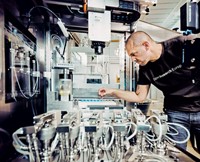Advertisement
Grab your lab coat. Let's get started
Welcome!
Welcome!
Create an account below to get 6 C&EN articles per month, receive newsletters and more - all free.
It seems this is your first time logging in online. Please enter the following information to continue.
As an ACS member you automatically get access to this site. All we need is few more details to create your reading experience.
Not you? Sign in with a different account.
Not you? Sign in with a different account.
ERROR 1
ERROR 1
ERROR 2
ERROR 2
ERROR 2
ERROR 2
ERROR 2
Password and Confirm password must match.
If you have an ACS member number, please enter it here so we can link this account to your membership. (optional)
ERROR 2
ACS values your privacy. By submitting your information, you are gaining access to C&EN and subscribing to our weekly newsletter. We use the information you provide to make your reading experience better, and we will never sell your data to third party members.
Informatics
Automated chemistry specialist Chemify lands $43 million in funding
A computational language standard for chemical design and synthesis garners interest
by Rick Mullin
August 9, 2023

Chemify, a developer of automated molecular design, discovery, and synthesis technology, has received $43 million in funding in a series A round led by Triatomic Capital. The firm’s goal is to make complex molecules on demand using a new chemical programming language.
Founded in 2019 and spun out from the University of Glasgow in March 2022, Chemify is based on chemistry, robotics, and artificial intelligence (AI) research performed at the University of Glasgow’s Digital Chemistry Laboratory. The lab is led by Leroy “Lee” Cronin, Chemify’s CEO.
Chemify is one of several organizations combining AI and robotics in automated pharmaceutical and materials discovery and synthesis labs. It is a relative newcomer to a field that includes units of IBM, SRI International, and Eli Lilly and Company, as well as myriad academic labs and spin outs.
What sets Chemify apart, according to Cronin, is its computational language, XDL, which he says closes a gap between the AI and robotics elements of automated discovery and synthesis. The program gives researchers access to a digital representation of unit operations in chemistry, Cronin says. This establishes a hardware-agnostic protocol for the computational aspect of an automated lab.
“Ironically, we have built the IBM PC standard for chemistry,” he says, comparing XDL to the operating system standard for personal computers adopted by Microsoft and other computer firms. IBM, an innovator in AI, has developed its own automated chemical discovery and synthesis approach called RoboRXN. IBM declined to be interviewed for this story.
Scientists building and operating automated labs recognize XDL’s potential as a computational standard for their operations. But other protocols are also being developed. For example, the Open Reaction Database, a consortium of academic and industry researchers that launched in 2019, is working on an open access chemical reaction database to support machine learning in experimental design, prediction, and synthesis.
“Indeed, XDL is a useful tool to document how to make chemical reactions reproducible,” Alán Aspuru-Guzik, a professor of chemistry and computer science at the University of Toronto, says in an e-mail. Aspuru-Guzik runs an automated lab that deploys a large-language AI model to control its robots. He’s also a founder of the autonomous discovery firm Kebotix. “The challenge for Chemify would be ensuring everybody in the industry adopts the standard,” he says.
The strong financial backing of Chemify signals “a maturing competitive market in this area,” Aspuru-Guzik says. “The next step will be to continue showing these self-driving laboratories’ relevance for chemical applications across the industry.”



Join the conversation
Contact the reporter
Submit a Letter to the Editor for publication
Engage with us on Twitter